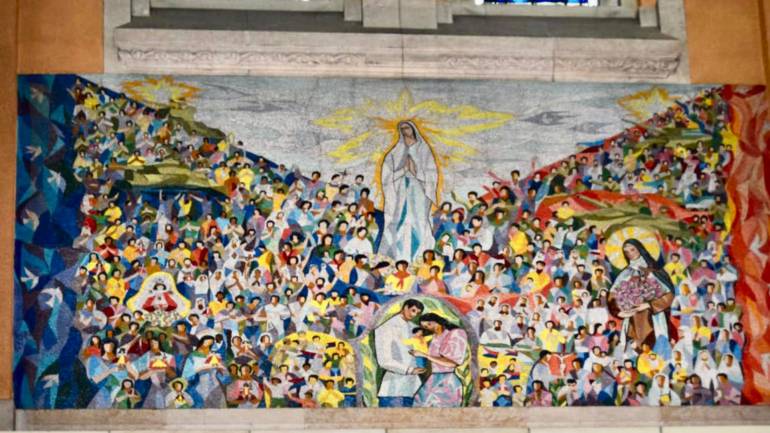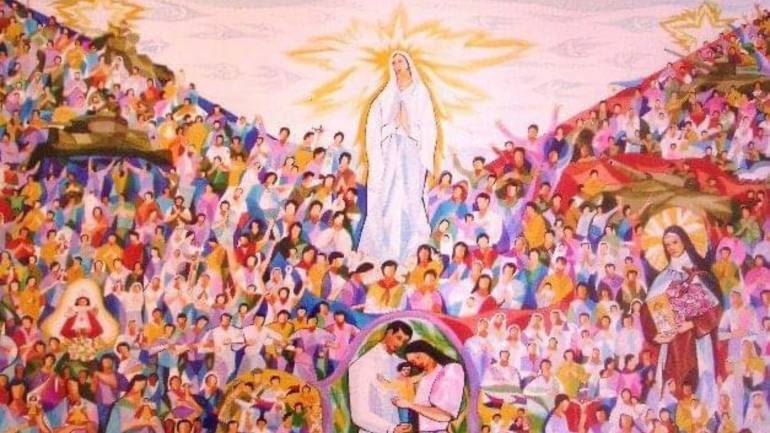People Power Revolt in Glass Mosaic Hangs in France's Basilica of St. Therese

Editor's note: This article updates the September 16, 2008, Philippine Daily Inquirer article.
"In Lisieux, France, the glass mosaic mural of the People Power Revolt That Stunned the World hangs in the Basilica of St. Therese." Malou Guanzon-Apalisok
Twenty-five (25) years after Filipinos peacefully overthrew a military dictatorship, the largest church constructed in the 20th century now preserves the legacy of the People Power revolution that astounded the world.
The Basilica of St. Therese of the Child Jesus in Lisieux, in Normandy, France, was built in the 1930s, five years after the saint’s canonization. Mosaic art depicting saints and angels adorns and illuminates its high walls lavishly. On the west side of the church’s interior hangs a contemporary addition: a glass mosaic mural representing the 1986 Philippine People Power peaceful revolution.
Asked how the project came to be, then-Philippine Ambassador to France Jose A. Zaide told the author that in 2006, he and his wife went on a pilgrimage to Lisieux, Normandy. Countries like Canada, Croatia, Zimbabwe, and Poland donated pieces or objects displayed on the side altars of the massive Basilica during Zaide's visit to the Basilica dedicated to the 2nd patron of France. Zaide said he thought of donating an icon from the Philippines and conveyed his wish to the Apostolic Nuncio in France, who in turn advised him to coordinate with Monsignor Bernard Lagoutte, the Basilica rector.
Around this time, Zaide had already discussed the project with his friend, Manny Baldemor, a frequent visitor to Paris. Baldemor subsequently boarded and traveled to Lisieux to meet with Monsignor Lagoutte. In 2007, the Filipino artist returned incognito and stayed in a small inn near the Basilica of St. Therese. Speaking to Ms. Guanzon-Apalisok through an interpreter, Monsignor Lagoutte said that Baldemor took in all the inspiration while silently visiting the basilica for three days.
People Power in bursting colors
At the end of Baldemor’s stay in Lisieux, he presented Monsignor Lagoutte with a watercolor painting that depicts the 1986 People Power Revolution in bursting colors. Filipinos in France intended to donate a glass mosaic design to the Basilica of St. Therese to commemorate the Philippines' bloodless revolution in 1986.
The project estimation amounted to €34,000.00, or over P2 million in Philippine currency. Filipinos living in France did not hesitate to contribute. Various amounts poured in, including proceeds from a Bayanihan Dance Company program and a bazaar offering Filipino foodstuffs and gift items sponsored by women employees of the Philippine Embassy in the French capital.
Fr. Gil Apuli, a Filipino priest, endorsed a donation to Monsignor Lagoutte, while Mr. Elpi Caimoy, the president of the parish pastoral council of a Filcom attached to the St. Bernadette parish in Auteil, Paris, launched a fundraising project among Filipino communities.
On September 4, 2008, Ambassador Zaide traveled to Lisieux to hand over a check for an undisclosed amount to Monsignor Lagoutte. A simple ceremony for the event. Monsignor Lagoutte welcomed the Filipino envoy, who came with his wife, embassy official Maria Josefa Brock, and legal assistant Anika Fernandez. Together with Fr. Gil Apuli, head, and some members of a Filipino community, they had lunch with Monsignor Lagoutte at the Hermitage.

People Power mosaics use materials usually utilized in Murano art glass creations
It took less than two years to complete the People Power glass mosaic mural. Lampworked glass, the same material typically used in most Murano art glass creations, forms it. Two French artisans, Sylvie Henot and Francois Sand, worked with Mr. Baldemor to create the Murano glass mural. It is displayed on the left side of one of the basilica’s side altars, near the church’s main entrance.
The illustration does not include prominent politicians who participated in the People Power revolt, such as the slain former opposition Senator Benigno Ninoy Aquino, Jr., Corazon, his widow, who became President, and the late dictator Ferdinand Marcos and his wife Imelda. Only military tanks give reminders of the brutal martial law regime.
The image of the Blessed Virgin Mary dressed in a white robe and illuminated by enormous rays around her head serves as the main character in Baldemor's work. On both sides of the panel, opposite the Virgin's image, are two stars that share the light from the Virgin's direction. The images above show doves flying in the same illumination. Below her image is an illustration of a man and woman holding a young boy in the likeness of a Filipino family.
On the right side, the figure of St. Therese of the Child Jesus is prominent, holding a picture and crucifix bedecked with flowers, as well as the image of a man believed to be the first Filipino saint, Lorenzo Ruiz.
Except for images of military tanks below the two stars, a glance at Baldemor’s work makes the 1986 bloodless revolution look like a Catholic feast: people in colorful Filipino costumes carrying religious articles like a crucifix and the Child Jesus in the image of the Santo Nino.
Baldemor wrote a text about the peaceful revolt that surprised the world: a peaceful, moral crusade where, he said, “God was present.”
According to published reports, Philippine ambassadors in France, Belgium, and the Netherlands, along with French diplomats and their staff, attended the unveiling of the glass mosaic mural on October 18, 2009. The well-loved French saint's Basilica celebrated the artwork's dedication with a high mass.
* The writer is a Cebu City journalist who visited the Basilica of St. Therese in Lisieux, France, with Philippine Embassy officials on September 9, 2008. The writer interviewed Monsignor Bernard Lagoutte via an interpreter.








